April 7th, 2022
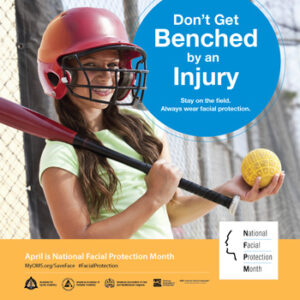 April is National Facial Protection Month, and the team at Bel Air Orthodontics want to remind parents, coaches and athletes to play it safe as they prepare to suit up for both recreational and organized sports. Whether at practice, at a game, or simply enjoying some fun in the neighborhood, a sports-related injury can happen in an instant. That's why it's important to take precautions to protect your face and teeth from injury. Dr. Godwin suggests you take these simple steps to prevent injuries so you can stay in the game:
April is National Facial Protection Month, and the team at Bel Air Orthodontics want to remind parents, coaches and athletes to play it safe as they prepare to suit up for both recreational and organized sports. Whether at practice, at a game, or simply enjoying some fun in the neighborhood, a sports-related injury can happen in an instant. That's why it's important to take precautions to protect your face and teeth from injury. Dr. Godwin suggests you take these simple steps to prevent injuries so you can stay in the game:
- Wear a mouth guard when playing contact sports; if you have braces, make sure you use a mouth guard designed specially for orthodontic patients;
- Wear a helmet. Helmets reduce of risk of head injury by absorbing the energy of an impact.
- Wear protective eye wear. According to the Coalition to Prevent Sports Eye Injuries, protective eye wear designed specifically for the sport can prevent more than 90 percent of all eye injuries;
- Wear a face shield to avoid scratched or bruised skin;
- Be alert - as a player or spectator!
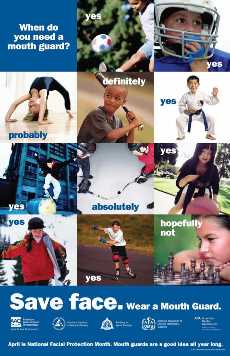 Did You Know? . . .
Did You Know? . . .
- Athletes who don't wear mouth guards are 60 times more likely to damage their teeth. Mouth guards are particularly important if you are in orthodontic treatment. A minor blow to the face can be uncomfortable if you don't have braces; but add metal to the mix and a minor blow to the face can leave you with abrasions and cuts inside your mouth from your soft tissue being pressed against the brackets and wires on your teeth;
- Sports-related injuries are the leading cause of emergency room visits in children ages 12 to 17 according to the Center for Disease Control;
- Whatever your sport, the right protective gear can save your teeth, your face, and even your life. If you or your child suffers dental trauma such as a knocked-out or broken tooth, Dr. Godwin suggests that you contact your dentist for immediate attention. For those in braces, it's also important to contact our office to schedule an appointment for repair since damage to braces can lengthen treatment time and affect treatment results.
About National Facial Protection Month: Every April, the American Association of Orthodontists, the American Dental Society, the Academy for Sports Dentistry, the American Association of Oral and Maxillofacial Surgeons, and the American Academy of Pediatric Dentistry team up to remind parents, coaches and athletes about the importance of taking precautions to preserve their teeth and protect them from facial injuries.
March 22nd, 2022
It is not unusual for elastics (a.k.a. rubber bands) to be prescribed as part of your orthodontic treatment when you are wearing braces. Your braces, which consist of brackets and wires, work by gently applying pressure to the teeth, and that pressure causes them to move into the correct position. In some cases, elastics are placed on your braces in strategic places in order to apply additional pressure.
How Elastics Work
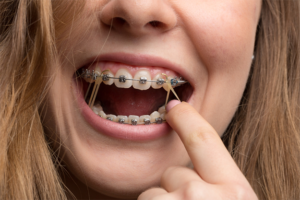 Customized for each patient, the elastics typically stretch over tiny loops on the top and bottom brackets. When worn as prescribed, these tiny elastics will apply the gentle and steady pressure needed to guide your teeth into the desired position and align one arch to the other. Without the use of these elastics, you may not be able to achieve the results you want, or you may have to wear braces for a longer period of time.
Customized for each patient, the elastics typically stretch over tiny loops on the top and bottom brackets. When worn as prescribed, these tiny elastics will apply the gentle and steady pressure needed to guide your teeth into the desired position and align one arch to the other. Without the use of these elastics, you may not be able to achieve the results you want, or you may have to wear braces for a longer period of time.
The Do's and Don'ts
Elastics must be worn as prescribed, and patient cooperation is essential to a successful outcome. Here's how you can do your part:
- DO - Change your elastics at least once a day. Remember to always wash your hands before removing and replacing the elastics;
- DON'T - Double up on elastics as this will cause too much pressure on the tooth or teeth and can actually harm the root of the tooth;
- DO - Get in the habit of carrying around an extra bag of elastics and replace them as soon as one breaks. By consistently wearing your elastics, you may shorten the overall time needed to wear braces;
- DON'T - Guess how they should be worn. If you are unsure where to place the elastics, call our office immediately so that we can help you get your elastics placed correctly;
- DO - Remove your elastics when eating and brushing your teeth, but remember to replace them when you are done.
- DON'T - Overstretch or overuse the same elastics or they will lose their strength and will be ineffective. You can avoid this by changing your elastics daily.
- DO - Call us immediately if you lose or run out of elastics. Please do not wait until your next regularly scheduled visit.
- DON'T - Forget to wear them consistently, as directed. By wearing your elastics exactly as prescribed, you will get better, faster, and more comfortable results. Generally, any discomfort from the elastics will disappear within a day or two, so hang in there.
- DO - Have fun with your braces and elastics. Elastics come in many different colors, so pick your favorite colors and show off your gorgeous smile!
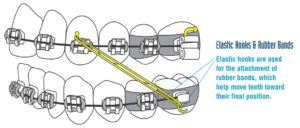 Elastics are a key part of your orthodontic treatment, and learning how to remove and replace them correctly is an important part of your treatment. Before we send you on your journey to a happy, healthy smile, we'll make sure you understand all there is to know about taking care of your braces. Of course, if you have any questions about your orthodontic treatment, be sure to give the team at Bel Air Orthodontics a call.
Elastics are a key part of your orthodontic treatment, and learning how to remove and replace them correctly is an important part of your treatment. Before we send you on your journey to a happy, healthy smile, we'll make sure you understand all there is to know about taking care of your braces. Of course, if you have any questions about your orthodontic treatment, be sure to give the team at Bel Air Orthodontics a call.
March 9th, 2022
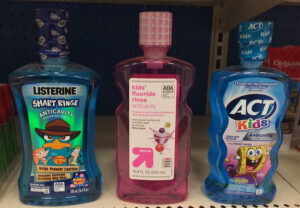 There are so many ways you can protect your teeth throughout your orthodontic treatment. We recommend you brush your teeth at least two times per day, floss regularly and protect your mouth and appliances from damage by making smart food choices. But did you know there is another, often forgotten, way to keep your teeth clean and healthy during your treatment? Fluoride, a mineral found in your water and many dental products can keep your teeth strong.
There are so many ways you can protect your teeth throughout your orthodontic treatment. We recommend you brush your teeth at least two times per day, floss regularly and protect your mouth and appliances from damage by making smart food choices. But did you know there is another, often forgotten, way to keep your teeth clean and healthy during your treatment? Fluoride, a mineral found in your water and many dental products can keep your teeth strong.
What is Fluoride And How is It Used?
Fluoride is a mineral that helps prevent cavities and tooth decay. It comes in two varieties: topical and systemic. Topical fluorides are applied directly to the tooth enamel. Some examples include fluoride toothpastes and mouth rinses, as well as fluoride treatments at your dentist's office. Systemic fluoride is swallowed and benefits the teeth before and after they erupt in the mouth. Examples include fluoridated water and dietary fluoride supplements.
The topical fluoride preparation used in the dental office is a much stronger concentration than that in toothpastes or mouth rinses that are available at your local pharmacy. A fluoride treatment typically takes just a few minutes. After the treatment, patients are asked not to rinse, eat or drink for at least 30 minutes in order to allow the teeth to absorb the fluoride. Your dentist may also prescribe a fluoride product such as fluoride gels or antibacterial mouth rinses. Dentists have used in-office fluoride treatments for decades to help protect their patients' oral health; so if you have questions about fluoride treatments and their benefits, don't hesitate to ask the team at Bel Air Orthodontics or your general dentist.
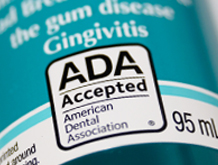 Look For The American Dental Association's Seal of Acceptance.
Look For The American Dental Association's Seal of Acceptance.
When choosing your own over-the-counter fluoride products, be sure to check for the American Dental Association's (ADA) seal of acceptance. Products marked with the ADA seal of approval have been examined carefully by the ADA's Council on Scientific Affairs and have met it's criteria for safety and effectiveness. Take care of your teeth and share your beautiful smile!
February 17th, 2022
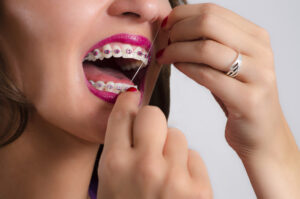 February is National Children's Dental Health Month, and the team at Bel Air Orthodontics want to remind everyone about the importance of good oral hygiene and the role it plays in the health of your teeth and the success of your orthodontic treatment.
February is National Children's Dental Health Month, and the team at Bel Air Orthodontics want to remind everyone about the importance of good oral hygiene and the role it plays in the health of your teeth and the success of your orthodontic treatment.
Brushing for two minutes, two times a day is the golden rule when it comes to taking care of your teeth; but did you know that brushing alone isn't enough to keep your mouth clean and disease free? The gum tissue between your teeth where your toothbrush can't reach is prone to infection. That's why flossing regularly is just as essential to your overall health care as brushing. The American Dental Association (ADA) suggests flossing at least once a day to promote total oral health.
Flossing With Braces
Flossing is more important that ever when you're in orthodontic treatment. Braces can catch food and allow plaque to build up around them, increasing the risk of gum disease. Flossing removes plaque from the areas of your teeth that your toothbrush can't reach. If you don't remove this plaque, it can harden into tartar and lead to gum inflammation and disease. Fortunately there are products to help you successfully floss around and between your braces. Here are some handy helpers that make it easier to floss while you're in treatment:
Floss Threaders
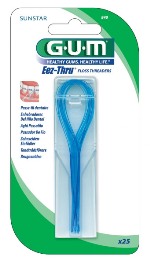 A floss threader is the most common tool to help you floss with braces. Made of a special, rigid plastic, a threader works like a sewing needle to help you guide the floss under the archwire so that you can floss as usual. Here's how it works:
A floss threader is the most common tool to help you floss with braces. Made of a special, rigid plastic, a threader works like a sewing needle to help you guide the floss under the archwire so that you can floss as usual. Here's how it works:
- Pull off 12 to 18 inches of your preferred dental floss.
- Insert one end of the dental floss about five inches into the loop of the threader.
- Pass the floss threader under or over the archwire.
- Remove the threader from the floss and floss gently back and forth and up and down into the gumline between the teeth.
- Repeat the process between each tooth.
Stiff-Ended Floss
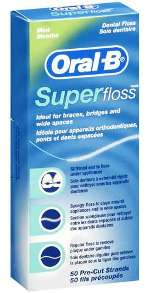 Made with a bendable but rigid segment at its end, this special floss works much the same as a floss threader. Products such as Oral-B's Super Floss have three unique components—a stiffened-end dental floss threader, spongy floss and regular floss.
Made with a bendable but rigid segment at its end, this special floss works much the same as a floss threader. Products such as Oral-B's Super Floss have three unique components—a stiffened-end dental floss threader, spongy floss and regular floss.
Simply maneuver the stiff end under the archwire of your braces, pull it through and floss as usual. All three flossing tools work together to give you maximum benefits.
Oral Irrigators
An oral irrigator, such as a Waterpik®, works by shooting a very fine jet of water between and around teeth to clear away plaque and food. This system can make cleaning around your braces much easier and more thorough. Dr. Godwin and the team at Bel Air Orthodontics highly recommend the use of an oral irrigator throughout your orthodontic treatment.
Regardless of the type flossing tool you use, make sure that you floss on a regular basis - at least once a day. Though flossing may add one more step to your daily routine, it's just as important to achieving a healthy smile as brushing. As always, let the team at Bel Air Orthodontics know if you have any questions about the best way to keep your teeth clean and healthy while you're in treatment.
 April is National Facial Protection Month, and the team at Bel Air Orthodontics want to remind parents, coaches and athletes to play it safe as they prepare to suit up for both recreational and organized sports. Whether at practice, at a game, or simply enjoying some fun in the neighborhood, a sports-related injury can happen in an instant. That's why it's important to take precautions to protect your face and teeth from injury. Dr. Godwin suggests you take these simple steps to prevent injuries so you can stay in the game:
April is National Facial Protection Month, and the team at Bel Air Orthodontics want to remind parents, coaches and athletes to play it safe as they prepare to suit up for both recreational and organized sports. Whether at practice, at a game, or simply enjoying some fun in the neighborhood, a sports-related injury can happen in an instant. That's why it's important to take precautions to protect your face and teeth from injury. Dr. Godwin suggests you take these simple steps to prevent injuries so you can stay in the game: Did You Know? . . .
Did You Know? . . .



 There are so many ways you can protect your teeth throughout your orthodontic treatment. We recommend you brush your teeth at least two times per day, floss regularly and protect your mouth and appliances from damage by making smart food choices. But did you know there is another, often forgotten, way to keep your teeth clean and healthy during your treatment? Fluoride, a mineral found in your water and many dental products can keep your teeth strong.
There are so many ways you can protect your teeth throughout your orthodontic treatment. We recommend you brush your teeth at least two times per day, floss regularly and protect your mouth and appliances from damage by making smart food choices. But did you know there is another, often forgotten, way to keep your teeth clean and healthy during your treatment? Fluoride, a mineral found in your water and many dental products can keep your teeth strong.
 February is National Children's Dental Health Month, and the team at Bel Air Orthodontics want to remind everyone about the importance of good oral hygiene and the role it plays in the health of your teeth and the success of your orthodontic treatment.
February is National Children's Dental Health Month, and the team at Bel Air Orthodontics want to remind everyone about the importance of good oral hygiene and the role it plays in the health of your teeth and the success of your orthodontic treatment.
